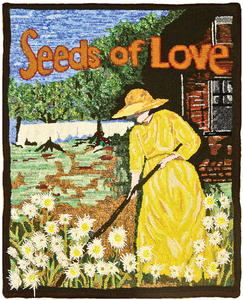The Making of the Lady in Yellow
The story behind the loops of a family heirloom

The Lady in Yellow (Seeds of Love), 24" x 28", #3- to 6-cut wool and cotton on monk's cloth. Adapted from a painting by Sheri Lynn Ray and hooked by Linday Anthony, Tampa, Florida, 2011.
My Seeds of Love rug is an adaptation of original artwork on the cover of a family cookbook entitled Seeds of Love – Tasty Tanner Traditions by Sheri Lynn Ray. Sheri is a sixth-generation Florida native who wrote the book and painted the cover artwork using a photograph of her great-great-grandmother, Sylvia Creetie Tanner, as inspiration.
This project is distinctly personal to me as well since the hardworking lady in yellow is also the grandmother of my husband, Larry Anthony. The very ground in which she works and the house in the background is located just across the street from my home on Tanner Road in Tampa. The Tanner family is designated as one of the original 22 pioneer families to settle eastern Hillsborough County, dating to the late 1800s. We currently claim 13 family households on the original acreage purchased from the railroad.
I began this project in February of 2011 and completed it just before Christmas of that same year. I wanted to create a family heirloom that would honor and compliment the family cookbook, Seeds of Love.
As the news of the “cookbook rug” traveled throughout our family, I found myself driven to get it just right and do the family proud. Our Uncle Luther Tanner was the only living child of the Lady in Yellow. As I hooked, he marveled at how his mother was coming to life in wool scraps! I was moved to tears when in June he offered his World War II army uniform to use as material for the rug. Although I was hesitant to cut up the uniform, I knew it would be meaningful and appropriate to include this personal touch to this “very Tanner” project.
The uniform was in wonderful condition, and the army green color was perfect. I knew exactly where I would put his bit of history into this piece and used it as the very darkest shade of green/brown hooked into various areas of the flower garden. The uniform still had all of the original buttons, and they became the yellow centers in many of the flowers.
This article is from the March/April/May 2014 issue. For more information on our issues, check out our issues page.







